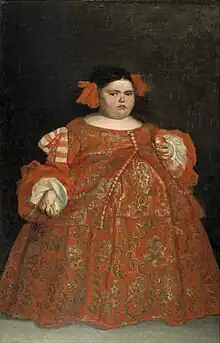Eugenia Martínez Vallejo | |
|---|---|
 Vallejo in 1680, as painted by Juan Carreño de Miranda | |
| Born | 1674 |
| Died | 1699 (aged approximately 25) |
| Nationality | Spanish |
| Known for | Subject of two portraits by Juan Carreño de Miranda |
Eugenia Martínez Vallejo (1674–1699) was a Spanish court jester. She gained notoriety for her large size and weight, now thought to be the result of Prader–Willi Syndrome.[1]
Biography
%252C_de_Juan_Carre%C3%B1o_de_Miranda..jpg.webp)
Vallejo was born in the small village of Merindad de Montija, Burgos, Spain in 1674, to Antonia de la Bodega and José Martínez Vallejo. Her parents were poor, and her mother gave birth to her in a church after her water broke during mass.[3][4][5]
As an infant, Vallejo had a decent appetite, and any initial weight gain was thought to have been a fortuitous sign, as both medical and aesthetic standards of the age considered slightly heavier frames on women to be preferable. By the time she was one year old, she had already reached a weight of 25 kg (55 lbs).[3]
By the age of six, Vallejo already weighed 70 kg (155 lbs). News of her condition had spread to Madrid, and it was at this age that she was summoned there to the court of Spanish regent Charles II in 1680. So fascinated was the king by her appearance that he had his court painter, Juan Carreño de Miranda, a noted Baroque portraitist, create two full-body portraits of her: one clothed in formal dress and one nude.[6] The paintings are titled The Monster - Dressed and The Monster - Nude respectively.[5][7]
Within the court she fulfilled the functions of a jester,[8] her appearance serving as a source of shock and amusement.[5][7] This situation was not uncommon for people with significant physical deformities during this time. Many monarchs held disfigured and disabled people in the ranks of their courts, often exploiting them for entertainment.[4][9] Despite her presence in the court, there are no records of financial accommodation given to her, and so it is likely that she was only brought in during certain events as entertainment.[5]
Martínez Vallejo died in 1699.
Legacy
.jpg.webp)
The two portraits by Carreño are currently held by the Museo del Prado in Madrid.[5][9] In 1997, a sculpture by Amado González Hevia, also known as "Favila," was commissioned for the city of Avilés. He created a bronze statue of Vallejo, which stands on calle Carreño Miranda and is popular with tourists.[10]
References
- ↑ Goldberg, Michael J. (1987). The Dysmorphic Child: An Orthopedic Perspective. New York: Raven Press. p. 165. ISBN 978-0881672381.
- ↑ Mary Jones. "Case Study: Cataplexy and SOREMPs Without Excessive Daytime Sleepiness in Prader Willi Syndrome. Is This the Beginning of Narcolepsy in a Five Year Old?". European Society of Sleep Technologists. Archived from the original on April 13, 2009. Retrieved April 6, 2009.
- 1 2 Dehesa, Jabato; Jesús, María (2018). "Breve noticia de Eugenia Martínez Vallejo, La Monstrua, una burgalesa en la corte de los Austrias" [Brief news of Eugenia Martínez Vallejo, La Monstrua, a woman from Burgos at the Austrias court]. Boletín de la Institución Fernán González (in Spanish). 256.
- 1 2 Rochet, Claire (2021-01-26). "The story of Eugenia Martinez Vallejo". Girl Museum. Archived from the original on 2021-05-12. Retrieved 2021-05-12.
- 1 2 3 4 5 "Eugenia Martínez Vallejo, Naked - The Collection - Museo Nacional del Prado". Museo del Prado. Archived from the original on 2021-05-12. Retrieved 2021-05-12.
- ↑ Beruete y Moret, Aureliano (1911). The School of Madrid. Duckworth and Company. pp. 204–205. Archived from the original on 2022-05-25. Retrieved 2022-04-23.
- 1 2 "Eugenia Martínez Vallejo, Clothed - The Collection - Museo Nacional del Prado". Museo del Prado. Archived from the original on 2021-05-12. Retrieved 2021-05-12.
- ↑ The Rough Guide to Spain (12th ed.). Routledge & Kegan Paul. 2007. p. 608. ISBN 978-1843537601.
- 1 2 MacMonagle, Niall (January 21, 2019). "What Lies Beneath: Eugenia Martinez Vallejo, clothed by Juan Carreno de Miranda". Independent. Archived from the original on 2021-05-12. Retrieved 2021-05-12.
- ↑ Mancisidor, Myriam (July 21, 2021). "La escultura de Avilés más fotografiada, "La Monstrua": casi ninguno conoce su historia ni el origen de su nombre". La Nueva España (in Spanish). Archived from the original on November 6, 2021. Retrieved November 5, 2021.